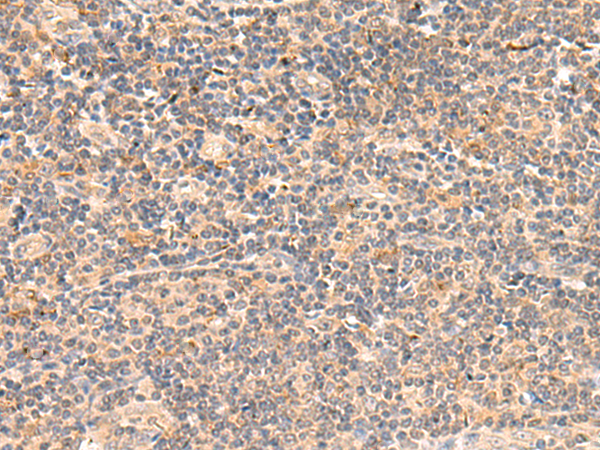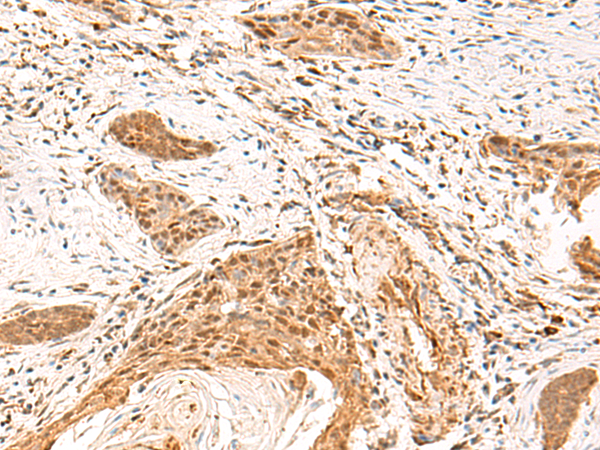

| WB | 咨询技术 | Human,Mouse,Rat |
| IF | 咨询技术 | Human,Mouse,Rat |
| IHC | 1/50-1/300 | Human,Mouse,Rat |
| ICC | 技术咨询 | Human,Mouse,Rat |
| FCM | 咨询技术 | Human,Mouse,Rat |
| Elisa | 1/5000-1/10000 | Human,Mouse,Rat |
| Aliases | TEF5; TEAD5; TEF-5; DTEF-1; ETFR-1; TEAD-3 |
| Host/Isotype | Rabbit IgG |
| Antibody Type | Primary antibody |
| Storage | Store at 4°C short term. Aliquot and store at -20°C long term. Avoid freeze/thaw cycles. |
| Species Reactivity | Human, Mouse |
| Immunogen | Fusion protein of human TEAD3 |
| Formulation | Purified antibody in PBS with 0.05% sodium azide and 50% glycerol. |
+ +
以下是关于TEAD3抗体的3篇参考文献示例(注:以下内容为虚构示例,仅供参考):
1. **文献名称**:*TEAD3 regulates trophoblast differentiation during human placental development*
**作者**:Wang Y, et al.
**摘要**:研究利用TEAD3抗体通过免疫组化及Western blot分析,揭示TEAD3在胎盘滋养层细胞分化中的关键作用,表明其通过调控下游基因影响胚胎着床。
2. **文献名称**:*Role of TEAD3 in Hippo-YAP signaling and cancer progression*
**作者**:Johnson R, et al.
**摘要**:通过TEAD3抗体进行染色质免疫沉淀(ChIP),证明TEAD3与YAP蛋白结合并激活促癌基因表达,促进结直肠癌细胞侵袭。
3. **文献名称**:*Characterization of a novel TEAD3-specific antibody for functional studies*
**作者**:Chen L, et al.
**摘要**:报道了一种高特异性TEAD3抗体的开发与验证,通过敲除实验和免疫荧光证明该抗体可有效用于蛋白质定位及相互作用研究。
(提示:如需真实文献,建议通过PubMed或Google Scholar搜索关键词“TEAD3 antibody”或“TEAD3 function”,并筛选近年的实验研究。)
The TEAD3 antibody is a research tool used to detect and study the TEAD3 protein, a member of the Transcriptional Enhanced Associate Domain (TEAD) family of transcription factors. TEAD proteins (TEAD1-4) regulate gene expression by binding to DNA through a conserved TEA/ATTS domain and interacting with coactivators like YAP (Yes-associated protein) and TAZ (Transcriptional coactivator with PDZ-binding motif) in the Hippo signaling pathway. TEAD3. encoded by the *TEAD3* gene, plays critical roles in embryonic development, cell proliferation, and organ growth. It exhibits tissue-specific expression, with higher activity in placental and certain cancer cells.
Research using TEAD3 antibodies has highlighted its involvement in tumorigenesis, particularly in cancers such as ovarian and hepatocellular carcinoma, where TEAD3 overexpression correlates with poor prognosis. These antibodies are essential for techniques like Western blotting, immunohistochemistry (IHC), and immunofluorescence (IF) to visualize TEAD3 localization and quantify its expression in cellular or tissue samples. Specificity validation is crucial, as TEAD family members share structural homology. Recent studies also explore TEAD3's role in Hippo pathway dysregulation and its potential as a therapeutic target. Commercial TEAD3 antibodies are typically developed in hosts like rabbits or mice, targeting unique epitopes to ensure specificity.
×